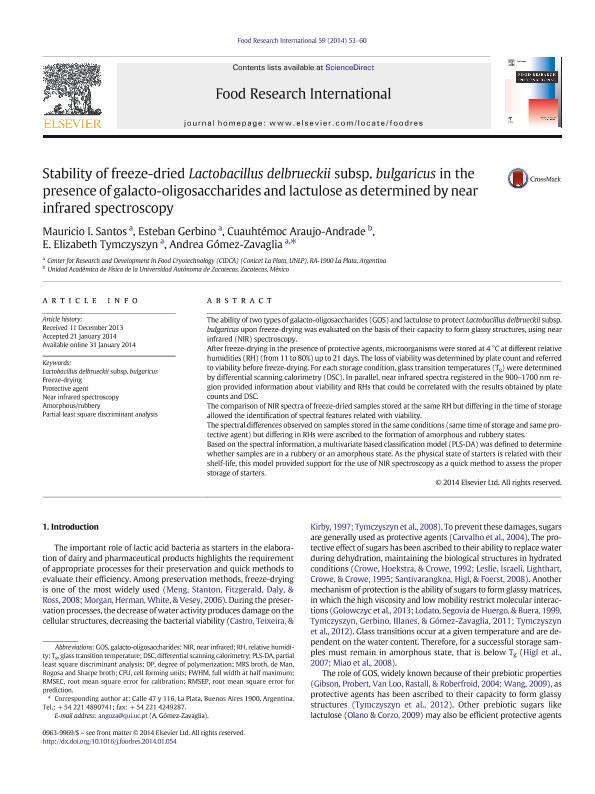Mostrar el registro sencillo del ítem
dc.contributor.author
Santos, Mauricio Ismael

dc.contributor.author
Gerbino, Oscar Esteban

dc.contributor.author
Araujo Andrade, Cuauhtemoc
dc.contributor.author
Tymczyszyn, Emma Elizabeth

dc.contributor.author
Gomez Zavaglia, Andrea

dc.date.available
2018-01-05T17:55:00Z
dc.date.issued
2014-02
dc.identifier.citation
Gomez Zavaglia, Andrea; Tymczyszyn, Emma Elizabeth; Araujo Andrade, Cuauhtemoc; Gerbino, Oscar Esteban; Santos, Mauricio Ismael; Stability of freeze-dried Lactobacillus delbrueckii subsp. bulgaricus in the presence of galacto-oligosaccharides and lactulose as determined by near infrared spectroscopy; Elsevier Science; Food Research International; 59; 2-2014; 53-60
dc.identifier.issn
0963-9969
dc.identifier.uri
http://hdl.handle.net/11336/32412
dc.description.abstract
The ability of two types of galacto-oligosaccharides (GOS) and lactulose to protect Lactobacillus delbrueckii subsp. bulgaricus upon freeze-drying was evaluated on the basis of their capacity to form glassy structures, using near infrared (NIR) spectroscopy. After freeze-drying in the presence of protective agents, microorganisms were stored at 4 °C at different relative humidities (RH) (from 11 to 80%) up to 21 days. The loss of viability was determined by plate count and referred to viability before freeze-drying. For each storage condition, glass transition temperatures (Tg) were determined by differential scanning calorimetry (DSC). In parallel, near infrared spectra registered in the 900–1700 nm region provided information about viability and RHs that could be correlated with the results obtained by plate counts and DSC. The comparison of NIR spectra of freeze-dried samples stored at the same RH but differing in the time of storage allowed the identification of spectral features related with viability. The spectral differences observed on samples stored in the same conditions (same time of storage and same protective agent) but differing in RHs were ascribed to the formation of amorphous and rubbery states. Based on the spectral information, a multivariate based classification model (PLS-DA) was defined to determine whether samples are in a rubbery or an amorphous state. As the physical state of starters is related with their shelf-life, this model provided support for the use of NIR spectroscopy as a quick method to assess the proper storage of starters.
dc.format
application/pdf
dc.language.iso
eng
dc.publisher
Elsevier Science

dc.rights
info:eu-repo/semantics/openAccess
dc.rights.uri
https://creativecommons.org/licenses/by-nc-sa/2.5/ar/
dc.subject
Lactobacillus Delbrueckii Subsp. Bulgaricus
dc.subject
Freeze-Drying
dc.subject
Protective Agent
dc.subject
Near Infrared Spectroscopy
dc.subject
Amorphous/Rubbery
dc.subject
Partial Least Square Discriminant Analysis
dc.subject.classification
Alimentos y Bebidas

dc.subject.classification
Otras Ingenierías y Tecnologías

dc.subject.classification
INGENIERÍAS Y TECNOLOGÍAS

dc.title
Stability of freeze-dried Lactobacillus delbrueckii subsp. bulgaricus in the presence of galacto-oligosaccharides and lactulose as determined by near infrared spectroscopy
dc.type
info:eu-repo/semantics/article
dc.type
info:ar-repo/semantics/artículo
dc.type
info:eu-repo/semantics/publishedVersion
dc.date.updated
2018-01-03T19:04:56Z
dc.journal.volume
59
dc.journal.pagination
53-60
dc.journal.pais
Países Bajos

dc.journal.ciudad
Amsterdam
dc.description.fil
Fil: Santos, Mauricio Ismael. Provincia de Buenos Aires. Gobernación. Comisión de Investigaciones Científicas. Centro de Investigación y Desarrollo en Criotecnología de Alimentos. Consejo Nacional de Investigaciones Científicas y Técnicas. Centro Científico Tecnológico Conicet - La Plata. Centro de Investigación y Desarrollo en Criotecnología de Alimentos. Universidad Nacional de La Plata. Facultad de Ciencias Exactas. Centro de Investigación y Desarrollo en Criotecnología de Alimentos; Argentina
dc.description.fil
Fil: Gerbino, Oscar Esteban. Provincia de Buenos Aires. Gobernación. Comisión de Investigaciones Científicas. Centro de Investigación y Desarrollo en Criotecnología de Alimentos. Consejo Nacional de Investigaciones Científicas y Técnicas. Centro Científico Tecnológico Conicet - La Plata. Centro de Investigación y Desarrollo en Criotecnología de Alimentos. Universidad Nacional de La Plata. Facultad de Ciencias Exactas. Centro de Investigación y Desarrollo en Criotecnología de Alimentos; Argentina
dc.description.fil
Fil: Araujo Andrade, Cuauhtemoc. Universidad Autonoma de Zacatecas; México
dc.description.fil
Fil: Tymczyszyn, Emma Elizabeth. Provincia de Buenos Aires. Gobernación. Comisión de Investigaciones Científicas. Centro de Investigación y Desarrollo en Criotecnología de Alimentos. Consejo Nacional de Investigaciones Científicas y Técnicas. Centro Científico Tecnológico Conicet - La Plata. Centro de Investigación y Desarrollo en Criotecnología de Alimentos. Universidad Nacional de La Plata. Facultad de Ciencias Exactas. Centro de Investigación y Desarrollo en Criotecnología de Alimentos; Argentina
dc.description.fil
Fil: Gomez Zavaglia, Andrea. Provincia de Buenos Aires. Gobernación. Comisión de Investigaciones Científicas. Centro de Investigación y Desarrollo en Criotecnología de Alimentos. Consejo Nacional de Investigaciones Científicas y Técnicas. Centro Científico Tecnológico Conicet - La Plata. Centro de Investigación y Desarrollo en Criotecnología de Alimentos. Universidad Nacional de La Plata. Facultad de Ciencias Exactas. Centro de Investigación y Desarrollo en Criotecnología de Alimentos; Argentina
dc.journal.title
Food Research International

dc.relation.alternativeid
info:eu-repo/semantics/altIdentifier/doi/http://dx.doi.org/10.1016/j.foodres.2014.01.054
dc.relation.alternativeid
info:eu-repo/semantics/altIdentifier/url/http://www.sciencedirect.com/science/article/pii/S096399691400060X
Archivos asociados
